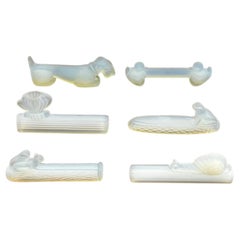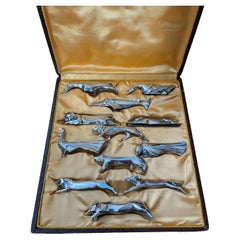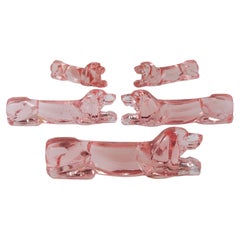Sabino Art Glass Tableware
Sabino art glass refers to the opalescent vessels, figurines and lighting fixtures that Marius-Ernest Sabino produced in the 1920s and ’30s and that epitomized the cosmopolitan glamour of Art Deco. Along with René Lalique and Emile Gallé, Sabino was part of a robust tradition of French creators of art glass that became a signature of Art Nouveau at the turn of the 20th century and who then pivoted to embrace the geometric style of Art Deco.
Sabino was born in Sicily in 1878, moving with his family in the 1880s to France. There his father was a sculptor working primarily in wood. Encouraged by his father to study fine art, Sabino attended both the École national supérieure des Arts Décoratifs and the École national supérieure des Beaux Arts de Paris. During his studies, he became fascinated by the new technologies for generating electricity and how they were changing the glass industry. Returning home following service in World War I, Sabino founded a factory that manufactured light fixtures in wood and bronze, but he quickly switched his focus to glass, as his experiments with the material yielded novel results. By 1925, he had developed an opalescent glass with the iridescence of soap bubbles or peacock feathers.
During the Great Depression, despite the era’s economic turbulence, Sabino’s designs for light fixtures, vases and figurines were in high demand. Among his sculptural pieces are large fish figurines, created in a limited edition in 1931, two of which were acquired by Maurice Chevalier and Josephine Baker. Like French fashion, graphic and interior design during the interwar period, Sabino chandeliers remain eternally chic. Many of his custom pieces are huge, such as the ones he created for the SS Île de France, in 1927, and for the Grand Salon of the SS Normandie, in 1935. No matter the size, however, one of their hallmarks is that the glass components are central to the overall design, rather than being merely ornamental. This quintessentially Art Deco molded-glass fixture, with its geometric form and floral pattern, perfectly captures the mix of subtlety and originality that characterizes the best examples of Sabino art glass.
1920s French Art Deco Vintage Sabino Art Glass Tableware
Opaline Glass
1930s French Art Deco Vintage Sabino Art Glass Tableware
Silver Plate
1930s Art Deco Vintage Sabino Art Glass Tableware
Glass
1930s French Art Deco Vintage Sabino Art Glass Tableware
Silver Plate
1930s Art Deco Vintage Sabino Art Glass Tableware
Glass
1930s French Art Deco Vintage Sabino Art Glass Tableware
Silver Plate, Metal
1920s French Art Deco Vintage Sabino Art Glass Tableware
Art Glass
1930s French Art Deco Vintage Sabino Art Glass Tableware
Opaline Glass
1930s French Art Deco Vintage Sabino Art Glass Tableware
Silver Plate
1930s French Art Deco Vintage Sabino Art Glass Tableware
Crystal
1920s Austrian Art Deco Vintage Sabino Art Glass Tableware
Silver Plate
1930s French Art Deco Vintage Sabino Art Glass Tableware
Silver Plate
1930s French Art Deco Vintage Sabino Art Glass Tableware
Art Glass
Sabino Art Glass tableware for sale on 1stDibs.
Creators Similar to Sabino Art Glass
- What is Sabino glass?1 Answer1stDibs ExpertMarch 15, 2024Sabino glass is the term for the opalescent vessels, figurines and lighting fixtures that Marius-Ernest Sabino produced in the 1920s and ’30s. Sabino was one of the French creators of art glass who helped make it a signature of Art Nouveau at the turn of the 20th century before pivoting to embrace the geometric style of Art Deco. Returning home following his service in World War I, Sabino founded a factory that manufactured light fixtures in wood and bronze, but he quickly switched his focus to glass as his experiments with the material yielded novel results. By 1925, he had developed an opalescent glass with an iridescence reminiscent of soap bubbles or peacock feathers. Many of his custom pieces are huge, such as the ones he created for the SS Île de France in 1927 and for the Grand Salon of the SS Normandie in 1935. On 1stDibs, explore a selection of Sabino art glass.
- 1stDibs ExpertFebruary 1, 2024To identify Sabino glass, search the piece for the maker's mark. Most glassware produced by the French glassworks features the words "Sabino," "Sabino Paris" or "Sabino France" engraved on the bottom or in another inconspicuous location. Depending on the age and style of the piece, the wordmark may be in cursive script or uppercase lettering. For assistance with identification, consult a certified appraiser or experienced dealer. On 1stDibs, find a collection of Sabino glassware.
- 1stDibs ExpertApril 22, 2024Whether Sabino glass has gold in it varies. Some pieces do feature genuine gold plating, which is a thin layer of the precious metal applied to the glass after production. Other art glass made by Sabino does not feature gold-plated detailing. Explore a variety of Sabrino glassware on 1stDibs.
- What is Sommerso art glass?1 Answer1stDibs ExpertApril 5, 2022Sommerso art glass is glassware that has two or more layers of color in the piece that don’t mix together. Associated with Murano glass, sommerso is Italian for “submerged.” Find a collection of Sommerso art glass on 1stDibs from some of the world’s top sellers.
- What is MCM art glass?1 Answer1stDibs ExpertApril 5, 2022MCM art glass is a shortened form of the phrase mid-century modern art glass. It describes works of art produced out of glass by artisans working during the middle of the 20th century. You'll find a variety of MCM art glass on 1stDibs.
- What does glass mean in art?1 Answer1stDibs ExpertApril 5, 2022In art, glass usually refers to decorative objects that are considered glass art. This means that they consist entirely or primarily out of glass, a hard brittle inorganic substance made out of natural materials like sand and limestone. Find a range of glass art on 1stDibs.
- Is art glass valuable?1 Answer1stDibs ExpertMarch 31, 2023Whether art glass is valuable depends on a number of factors. Who the maker is, what type of piece it is, how old it is, its condition, the number of pieces made and the current demand can all influence the price. A certified appraiser can help you determine how much a specific piece is worth. On 1stDibs, find a collection of art glass pieces.
- 1stDibs ExpertSeptember 23, 2024The art of making glass is called glassblowing. The name comes from the traditional glassmaking method of blowing through a long tube called a blowpipe to shape molten glass. Historians believe that glassblowing dates back to ancient Rome. On 1stDibs, find a wide range of glassware.
- Is stained glass Art Nouveau?1 Answer1stDibs ExpertApril 5, 2022Yes, some stained glass is Art Nouveau. It was during this period that Louis Comfort Tiffany produced his famed stained glass windows and decorative objects. However, the tradition of producing stained glass traces all the way back to the Gothic period. You'll find a selection of stained glass on 1stDibs.
- 1stDibs ExpertApril 5, 2022Yes, stained glass windows are indeed Art Deco. Between the 1920s and 1950s, color was an integral part of the movement, and stained glass, with its gorgeous hues, was highly celebrated. Find an assortment of stained glass windows from some of the world’s top sellers on 1stDibs.
- 1stDibs ExpertApril 5, 2022One way to tell if you have a piece of genuine hand-blown glass is to locate the pontil mark. This is a scar usually found on the bottom of the piece where the pontil was broken off from the glass object. An absence of this scar may indicate your glass piece was mold-blown. Shop a collection of vintage and contemporary hand-blown glass from some of the world’s top sellers on 1stDibs.


